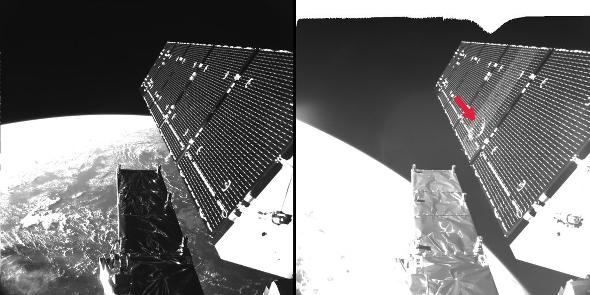Space debris is a growing problem. Space is big—as many of us like to say, that’s why we call it “space”—but over time collisions are inevitable. This can have catastrophic consequences, including the loss of a satellite … and if the collision is violent enough it can create even more debris, increasing the hazard over time.*
Large collisions are very rare, because big objects are few. But there are vastly more smaller objects in space than big ones, making smaller collisions more common. In fact, on Aug. 23, the European Space Agency satellite Sentinel-1A suffered an impact from a small object, probably just a few millimeters across, which slammed into one of its solar panels and left a visible dent nearly a half meter across.
The impact was noticed immediately by ground controllers; the amount of electricity from the panels getting to the spacecraft dropped by a few percent, the orientation of the spacecraft suddenly shifted, and the orbit changed a slight amount as well. An impact was suspected, and images taken by onboard cameras quickly confirmed the collision.
The damage is minimal, so the spacecraft is fine (the amount of power loss is small, onboard attitude control fixed the orientation, and the orbit is adjusted every week anyway). It’s no surprise the solar panel was hit, because they are the largest component of the spacecraft and present the biggest target. Had the main spacecraft been hit, though, it could have resulted in serious damage.

ESA
One thing that’s not clear is if the impactor was actual space debris (that is, human-made debris from another spacecraft) or a micrometeorite from deep space. Micrometeorites travel much more rapidly (more than 20 km/s versus perhaps 12 for space debris), so a smaller bit can make a bigger hole. According to the telemetry and the images, the impactor came in from the direction the spacecraft is moving. That strongly implies it was space debris in a similar polar orbit to Sentinel-1A; micrometeorites can come in from any direction and so an alignment with the satellite’s orbit would be highly unlikely.
I’ll note that space debris larger than a few centimeters across is tracked from the ground, but something the size of a grain of sand or a small pebble is far too small to be detected. That makes them very dangerous, but it’s not clear what can be done about them. There are plans to clean up larger debris, but smaller debris remains an issue.
It’s interesting that images were taken of the damage. Sentinel-1A is equipped with cameras, but they were only used to observe the solar panels unfolding after the satellite was first launched, and then they were turned off. They were turned back on after the impact to see if any damage was visible. It wouldn’t surprise me if more satellites were equipped this way in the future. There have been many cases where debris collisions have been suspected to cause satellite anomalies, but without pictures it’s hard to be sure.
The good news is that Sentinel-1A is OK. In fact the very next day after the collision it was used to survey Italy from space after a massive earthquake struck that country, and the observations are helping scientists understand the ground movement after the event.
Engineers and space scientists take the problem of debris collisions seriously, though it may be a while before real solutions are evident. Until then, the best we can do is hope our birds don’t get hit. I’m just glad Sentinel-1A survived its encounter.
*See the documentary Gravity, Bullock, S. and Clooney., G, 2013
